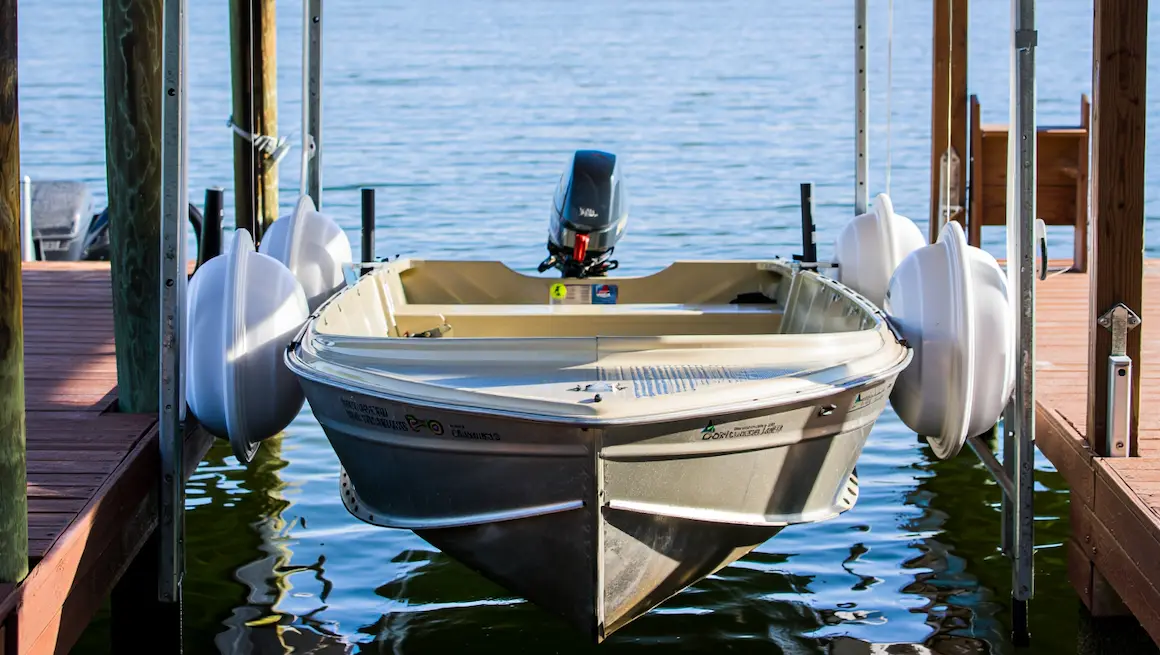If you’re a boat owner, you know how important it is to keep your vessel safe, secure, and perfectly aligned when stored on a boat lift. Misalignment can lead to costly damage, uneven weight distribution, and even accidents. That’s where DIY boat lift centering guides come in! These simple yet effective tools ensure your boat is perfectly centered every time you raise or lower it, saving you time, money, and frustration.
In this guide, we’ll walk you through everything you need to know about building your own DIY boat lift centering guides. Whether you’re a seasoned DIY enthusiast or a beginner looking to tackle your first project, we’ve got you covered. From the tools and materials you’ll need to step-by-step instructions and maintenance tips, this guide will help you achieve perfect alignment for your boat lift. Let’s dive in and get started!
Why Boat Lift Centering Guides Are Essential
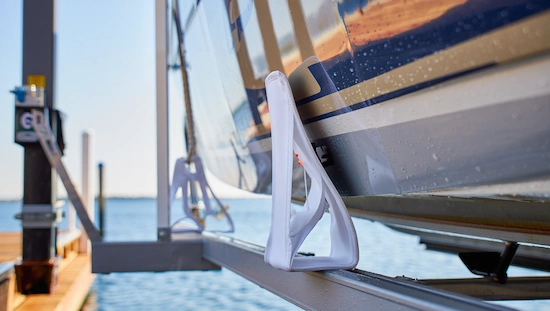
If you own a boat, you already know how important it is to keep it in pristine condition. One of the most overlooked yet critical aspects of boat maintenance is ensuring proper alignment on your boat lift. This is where DIY boat lift centering guides come into play. These guides are not just optional accessories—they’re essential tools for any boat owner who wants to protect their investment and ensure smooth operation. Here’s why:
1. Prevent Costly Damage to Your Boat
Misaligned boat lifts can cause significant damage to your vessel over time. When your boat isn’t centered properly, it can rub against the lift’s frame or hardware, leading to scratches, dents, or even structural damage. DIY boat lift centering guides ensure your boat is perfectly aligned every time you raise or lower it, minimizing the risk of wear and tear.
2. Ensure Safety for You and Your Boat
A misaligned boat lift isn’t just bad for your boat—it’s also a safety hazard. An uneven load can cause the lift to tilt or malfunction, potentially leading to accidents or injuries. By installing DIY boat lift centering guides, you can maintain a balanced and secure lift, giving you peace of mind every time you use it.
3. Extend the Lifespan of Your Boat Lift
Boat lifts are a significant investment, and proper alignment is key to keeping them in good working condition. Misalignment can put unnecessary strain on the lift’s motor, cables, and frame, leading to premature wear and costly repairs. DIY boat lift centering guides help distribute the weight evenly, reducing stress on the lift and extending its lifespan.
4. Save Money with a DIY Solution
Hiring a professional to install centering guides can be expensive, but with a little effort, you can build your own DIY boat lift centering guides at a fraction of the cost. Not only will you save money, but you’ll also gain the satisfaction of completing a practical and rewarding project.
5. Improve Boat Lift Performance
When your boat is perfectly centered, your lift operates more smoothly and efficiently. DIY boat lift centering guides eliminate the guesswork, ensuring your boat is aligned correctly every time. This means fewer adjustments, less frustration, and more time enjoying the water.
Tools and Materials Needed for DIY Boat Lift Centering Guides

Building your own DIY boat lift centering guides is a straightforward project, but having the right tools and materials is essential for success. Whether you’re a seasoned DIYer or a beginner, this list will ensure you have everything you need to create effective and durable DIY boat lift centering guides.
1. Essential Tools
- Measuring Tape: Accurate measurements are crucial for aligning your DIY boat lift centering guides properly.
- Drill and Drill Bits: You’ll need these to create holes for brackets and screws.
- Wrenches and Screwdrivers: These tools are necessary for tightening bolts and securing components.
- Level: A level ensures your DIY boat lift centering guides are perfectly aligned during installation.
- Saw (if cutting materials): If you’re customizing guide rails or brackets, a saw will be helpful.
- Marker or Pencil: For marking measurement points on your boat lift frame.
2. Materials for DIY Boat Lift Centering Guides
- Guide Rails: These are the main components of your DIY boat lift centering guides. Choose durable materials like aluminum or stainless steel to withstand water exposure.
- Centering Rollers or Brackets: These help guide your boat into the correct position. Look for high-quality, corrosion-resistant options.
- Bolts, Nuts, and Washers: Stainless steel hardware is ideal for securing your DIY boat lift centering guides without rusting.
- Spacers (if needed): These ensure proper alignment and spacing between the guide rails and your boat lift frame.
- Rubber or PVC Padding: Adding padding to your DIY boat lift centering guides can prevent scratches and reduce noise during operation.
3. Optional but Helpful Items
- Lubricant: Keeps the centering rollers or brackets moving smoothly.
- Safety Gear: Gloves, goggles, and ear protection to keep you safe during the project.
- Workbench or Clamps: These can make assembling your DIY boat lift centering guides easier and more precise.
4. Tips for Choosing Materials
- Durability: Since your DIY boat lift centering guides will be exposed to water and weather, opt for materials that resist rust and corrosion.
- Compatibility: Ensure the guide rails, rollers, and brackets are compatible with your boat lift model.
- Ease of Installation: Look for materials that are easy to cut, drill, and assemble if you’re new to DIY projects.
Step-by-Step Guide to Building DIY Boat Lift Centering Guides
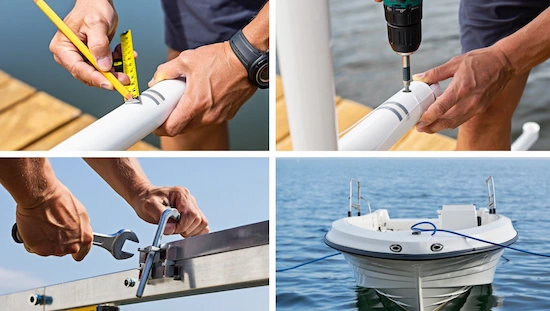
Building your own DIY boat lift centering guides is a rewarding project that ensures your boat is perfectly aligned every time you use your lift. Follow these step-by-step instructions to create effective and durable DIY boat lift centering guides:
Step 1: Measure and Mark the Alignment Points
- Start by measuring the width of your boat lift frame and the area where your boat rests. This will help you determine the correct placement for your DIY boat lift centering guides.
- Use a measuring tape and marker to mark the points where the guide rails and centering brackets will be installed. Double-check your measurements to ensure accuracy.
Step 2: Install the Guide Rails
- Attach the guide rails to the marked points on your boat lift frame. Use a drill to create pilot holes, then secure the rails with stainless steel bolts, nuts, and washers.
- Ensure the guide rails are level and evenly spaced. This is crucial for the proper functioning of your DIY boat lift centering guides.
Step 3: Add Centering Rollers or Brackets
- Install the centering rollers or brackets onto the guide rails. These components will help guide your boat into the correct position.
- Use spacers if necessary to ensure the rollers or brackets are aligned properly. Tighten all hardware securely to prevent movement during use.
Step 4: Test the Alignment
- Lower your boat lift and carefully guide your boat into position. Observe how the DIY boat lift centering guides interact with your boat.
- Make any necessary adjustments to the guide rails or rollers to ensure your boat is perfectly centered. Use a level to confirm everything is aligned correctly.
Step 5: Secure and Finalize the Installation
- Once you’re satisfied with the alignment, double-check all bolts and hardware to ensure they’re tight and secure.
- Add rubber or PVC padding to the guide rails or rollers if desired. This will protect your boat from scratches and reduce noise during operation.
Step 6: Perform a Final Test
- Raise and lower your boat lift several times to ensure the DIY boat lift centering guides are working as intended.
- Make any final adjustments to the rollers or brackets if needed. Your boat should now glide smoothly into perfect alignment every time.
Tips for Success
- Work Slowly and Carefully: Precision is key when building DIY boat lift centering guides. Take your time to ensure everything is measured and installed correctly.
- Use Quality Materials: Opt for durable, corrosion-resistant materials to ensure your DIY boat lift centering guides last for years.
- Safety First: Wear gloves, goggles, and other safety gear while working with tools and hardware.
Tips for Maintaining Proper Boat Lift Alignment
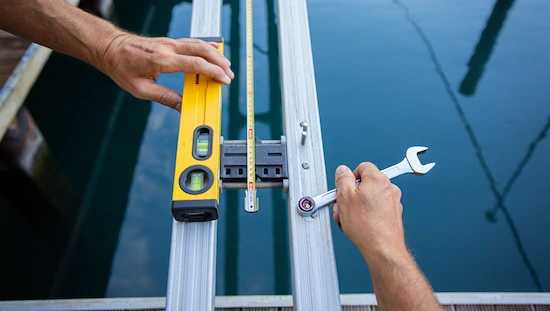
Once you’ve installed your DIY boat lift centering guides, proper maintenance is key to ensuring they continue to function effectively. Regular upkeep will not only extend the life of your DIY boat lift centering guides but also keep your boat safe and perfectly aligned. Here are some essential tips to help you maintain proper boat lift alignment:
1. Regularly Inspect Your DIY Boat Lift Centering Guides
- Check for Wear and Tear: Over time, the guide rails, rollers, and brackets in your DIY boat lift centering guides may show signs of wear. Inspect them regularly for rust, cracks, or loose hardware.
- Look for Misalignment: If your boat isn’t centering properly, inspect the DIY boat lift centering guides to see if any components need adjustment or replacement.
2. Lubricate Moving Parts
- Apply Lubricant: Keep the centering rollers and brackets in your DIY boat lift centering guides moving smoothly by applying a marine-grade lubricant. This prevents friction and reduces wear on the components.
- Focus on Pivot Points: Pay special attention to areas where metal parts rub against each other, as these are most prone to friction.
3. Tighten Loose Hardware
- Check Bolts and Screws: Vibrations from raising and lowering your boat lift can loosen bolts and screws over time. Regularly tighten all hardware in your DIY boat lift centering guides to ensure stability.
- Replace Damaged Hardware: If you notice any rusted or stripped bolts, replace them immediately to maintain the integrity of your DIY boat lift centering guides
4. Adjust Centering Rollers and Brackets
- Monitor Alignment: If your boat starts to drift to one side, it may be a sign that the centering rollers or brackets in your DIY boat lift centering guides need adjustment.
- Re-Measure and Realign: Use a level and measuring tape to ensure the guide rails and rollers are still perfectly aligned. Make adjustments as needed.
5. Protect Against Corrosion
- Use Rust-Resistant Materials: If you haven’t already, ensure your DIY boat lift centering guides are made from corrosion-resistant materials like stainless steel or aluminum.
- Apply Protective Coatings: Consider applying a protective coating or paint to metal components to prevent rust and extend their lifespan.
6. Clean Your DIY Boat Lift Centering Guides
- Remove Debris: Dirt, algae, and other debris can accumulate on your DIY boat lift centering guides, affecting their performance. Clean the guide rails and rollers regularly with water and a mild detergent.
- Inspect After Storms: After severe weather, check your DIY boat lift centering guides for damage or debris that may have been caused by wind, rain, or waves.
7. Monitor Boat Weight Distribution
- Avoid Overloading: Uneven weight distribution can strain your DIY boat lift centering guides and cause misalignment. Ensure your boat is loaded evenly and within the lift’s weight capacity.
- Adjust for Changes: If you add or remove heavy equipment from your boat, recheck the alignment of your DIY boat lift centering guides to ensure they’re still functioning properly.
Common Boat Lift Alignment Problems and Solutions
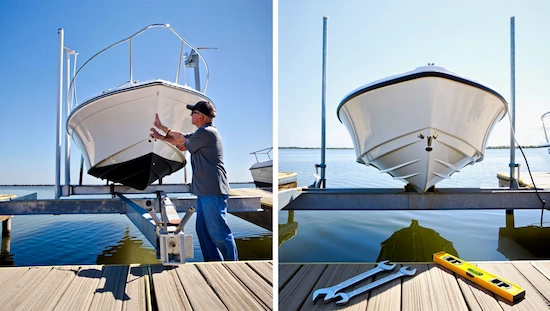
Even with well-built DIY boat lift centering guides, you may encounter alignment issues from time to time. Understanding these common problems and their solutions will help you keep your boat lift in top condition. Here’s a breakdown of the most frequent issues and how to address them:
1. Problem: Misaligned Boat Lift
- Symptoms: Your boat drifts to one side or doesn’t sit evenly on the lift.
- Solution:
- Check the DIY boat lift centering guides to ensure the guide rails and rollers are properly aligned.
- Re-measure and adjust the centering brackets or rollers as needed.
- Use a level to confirm the lift is even and make necessary adjustments.
2. Problem: Worn-Out Guide Rails or Rollers
- Symptoms: The boat doesn’t glide smoothly into position, or you notice visible damage to the rails or rollers.
- Solution:
- Inspect the DIY boat lift centering guides for signs of wear, such as rust, cracks, or uneven surfaces.
- Replace worn-out guide rails or rollers with new, corrosion-resistant components.
- Apply lubricant to new rollers to ensure smooth operation.
3. Problem: Difficulty Raising or Lowering the Boat
- Symptoms: The boat lift struggles to move up or down, or it gets stuck.
- Solution:
- Check the DIY boat lift centering guides for obstructions, such as debris or misaligned rollers.
- Ensure the guide rails are clean and free of dirt or algae buildup.
- Lubricate moving parts to reduce friction and improve performance.
4. Problem: Uneven Weight Distribution
- Symptoms: The boat tilts to one side, even when the DIY boat lift centering guides are properly installed.
- Solution:
- Redistribute the weight inside your boat to ensure it’s balanced.
- Check the DIY boat lift centering guides to confirm they’re properly aligned and adjusted.
- Add additional centering brackets or rollers if necessary to support the heavier side.
5. Problem: Loose or Damaged Hardware
- Symptoms: The DIY boat lift centering guides feel unstable, or you notice bolts and screws coming loose.
- Solution:
- Tighten all bolts, nuts, and screws in the DIY boat lift centering guides to ensure stability.
- Replace any rusted or damaged hardware with stainless steel components to prevent future issues.
- Regularly inspect the hardware as part of your maintenance routine.
6. Problem: Corrosion or Rust
- Symptoms: Metal components in the DIY boat lift centering guides show signs of rust or corrosion.
- Solution:
- Clean the affected areas with a wire brush and apply a rust-resistant coating.
- Replace severely corroded parts with new, durable materials like stainless steel or aluminum.
- Regularly inspect and maintain the DIY boat lift centering guides to prevent future corrosion.
7. Problem: Noisy Operation
- Symptoms: The DIY boat lift centering guides make squeaking or grinding noises during use.
- Solution:
- Apply a marine-grade lubricant to the guide rails, rollers, and brackets to reduce noise.
- Check for loose or misaligned components and tighten or adjust them as needed.
- Add rubber or PVC padding to the DIY boat lift centering guides to minimize friction and noise.
Proactive Tips to Avoid Alignment Problems
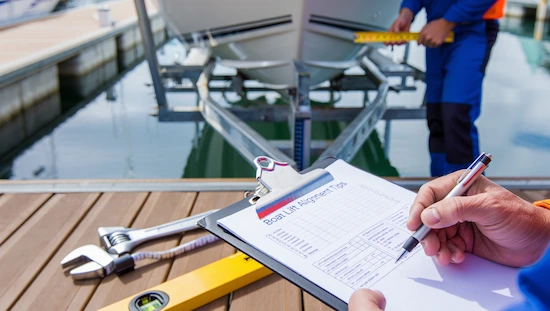
- Regular Inspections: Periodically check your DIY boat lift centering guides for signs of wear, misalignment, or damage.
- Routine Maintenance: Clean, lubricate, and tighten all components as part of a regular maintenance schedule.
- Use Quality Materials: Invest in durable, corrosion-resistant materials for your DIY boat lift centering guides to minimize future problems.
Conclusion
Building and maintaining DIY boat lift centering guides is a practical and cost-effective way to ensure your boat stays perfectly aligned and secure on its lift. By following the steps and tips outlined in this guide, you can create durable DIY boat lift centering guides that protect your boat, extend the life of your lift, and make every boating experience smoother and safer.
Whether you’re tackling this project for the first time or looking to improve your existing setup, DIY boat lift centering guides offer a simple yet powerful solution to common alignment problems. With regular maintenance and a little DIY effort, you’ll enjoy peace of mind knowing your boat is always in the right position.
So, what are you waiting for? Grab your tools, gather your materials, and start building your DIY boat lift centering guides today. Your boat—and your wallet—will thank you!

